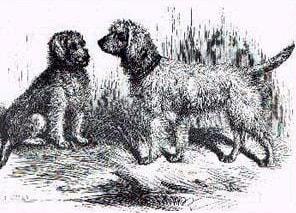Breed history


The Bedlington Terrier is one of the oldest Terrier breeds. It is descended from the Terrier type dogs that lived in Northumberland, Coquet valley, and Rothbury in the 18th century. Miners especially appreciated them as ratters in the mines. There are many theories about the Bedlington Terrier's development. According to tradition the short legged variety of the dogs came to be called Dandie Dinmont Terriers, while the long legged variety became Bedlington Terriers. The first dog to be specifically named as a Bedlington Terrier was Young Piper, bred in 1825 by Joseph Ainsley, who lived in Bedlington.
The Bedlington Terrier was bred to be a versatile everyman's working dog. Therefore it was good for many different tasks: as a ratter; a fast and fearless hunter both on the moors and in the caves; a tenacious foe in badger-baiting, a cruel but one-time popular pastime; as a ferocious fighter in brutal dog fights. The Bedlington was said to be the gamest of the local Terriers, and it was not afraid of even the most fearsome opponent. Later on the demands changed and it was bred to be more sophisticated. Dog shows grew in popularity and England's first Bedlington Terrier club was founded in 1869. The oldest club today is The National Bedlington Terrier Club registered by English Kennel Club in 1898.
Bedlingtons in Finland
In Finnish dog shows Bedlingtons were first seen in 1907. The dog and bitches seen were the Scottish imports, Lord, Leddy, and Flora, respectively. Of Lord and Leddy's litter in 1908 at least one bitch was registered. During the First World War the population disappeared but reappeared in 1925 when Bedlingtons were once again seen in Finnish dog shows. This time, too, the dogs were imports from Britain: the dog Yorkshire Lad and the bitch Susie. Even though the dogs produced a litter, this population did not last either. A permanent Finnish Bedlington population was started in 1956 by an import from Denmark, Jalnas Furstinnan Bae-Bae imported by Margot Nystedt. Second import was Mrs. Rea Hannula's Blue-Light from Denmark. Other imports in the 1960's came from England, Sweden and Holland. In the light of Finnish Bedlingtons today the most significant work was done by Mrs. Rea Hannula and her kennel Peggen.
Registrations grew steadily and reached their peak in 1969 at 82 dogs. Registrations have averaged approximately 50 dogs/year in the 1970's, 20 dogs/year in the 80's, and 14 dogs/year in the 90's. The registrations have increased slightly. There were approximately 23 registrations/year between 2000–2005.